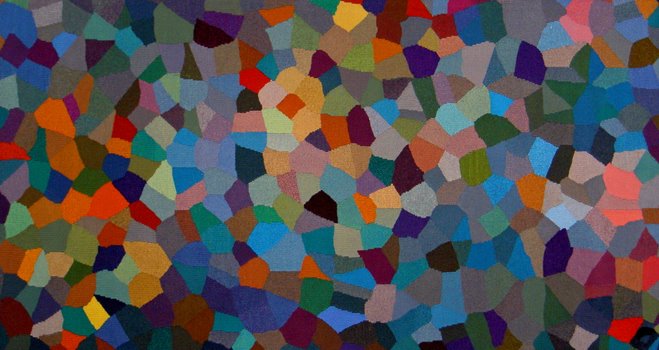Second panel of the tapestry installation, Fate, Destiny and Self-Determination/le sort, le destin et l'auto-determination, woven entirely by me (Line Dufour) and was assisted by Agota Dolinay, Jutta Polomski, Bambi Rutledge and Carla Duncan in the finishing. If I forgot anyone please let me know.
work-in-progress at the gallery. We are all very excited about this very good news and having a chance to celebrate your contribution to this tapestry endeavour. It has been a wonderful journey sharing this weaving project with all of you!
detail of the second panel of Fate, Destiny and Self-Determination/le sort, le destin and l'auto-determination.
In addition, Aneesha Perrone has solicited Regis University Library in Denver Colorado to exhibit the tapestry installation sometime in the summer of 2015, and they are collaborating with the Smithsonian to firm up the plans. We are also welcoming any other venues that might like to exhibit the installation from all over the world. Go to this website to read about Aneesha's exhibit which sounds wonderful. She has a life-affirming philosophy that permeates her work and her way of living: http://regislibrarynews.wordpress.com/2014/05/02/terra-firma-intrinsic-reflections-exhibit-and-opening-reception/. Her own website is here: www.arpanaaneeshastudio.com
Here is part of my artist statement about the tapestry installation:
Fate is defined as a
force, energy, principle, element or power that prescribes to each person a set
of limits, boundaries and confines. In Islam it is called Kismet.The Greeks called Fate, Moira.
Greek Mythology speaks of the three Fates: Clotho, Lachesis and Atropos who
supposedly controlled each person’s fate. The youngest, Clotho, is a spinner and she determines the time of
birth and spins the thread of life on her distaff. Lachesis measures the length
of the thread to determine the length of one’s life; the time of death is
decided by Atropos, who cuts the thread. Inherent in the idea of Fate, is that
one has no influence over events and outcomes. Mythology and psychology distinguish
between Fate and Destiny. Destiny, is considered an expanding field of
possibilities alluding to our potential to influence our Fate. This makes
Destiny kinetic. “The lives we construct are an inextricably woven fabric of
influences, possibilities and accumulated consequences of choices made.” (All
that Matters)
Fate, Destiny
and Self Determination/le destin et l’auto-determination is composed of
three sections. People were invited to visit the Toronto Weaving School in
Toronto where they co-created Section 2 of the tapestry grouping. Section 1 was
woven by myself in the studio These two approaches make reference to the traditional
manner tapestries were/are created. The
small shapes of section three are woven by people all over the world and can be
reconfigured by the curator or artist, so that the tapestry installation can be
viewed in different ways. Placement of the various sections changes and results
in a new view, referencing the element of chance, of destiny and of fate. 180
shapes have been received from 23 countries such as Australia, New Zealand,
Korea, USA, Mexico, Canada, Israel, France, Belgium to name a few. The names of
each participant can be included with the installation if the curator wishes. Fate,
Destiny and Self Determination/Le sort, destin et l’auto-determination poses
technical challenges by attempting to create irregular shapes within the rigid
confines of the tapestry technique. Technical challenges create tension for the
maker/artist which is representative of the ensuing tensions created by
asserting our will, despite all the challenges and obstacles, and the change that we as individuals undergo
or can effect.
Weaving is an
appropriate metaphor for engagement and activity with others, which
Fate, Destiny and Self Determination/Le
sort, destin et l’auto-determination embraces. All these individuals participating in this project are like
threads woven into an international and
multicultural community fabric through this one shared activity, a permanent
reminder of our shared heritage, culture and values.
In an earlier blog I announced that my tapestry Divine Intervention was selected to be exhibited at the New Hampshire Institute of Art in Manchester, New Hampshire in October 2014. I have since learned that this will be a travelling exhibition and two more venues will be hosting the exhibition: It will then travel to the George School in Newtown, PA (near Philadelphia) in December and then to Deerfield Academy, Deerfield, MA (Connecticut River Valley, Western Massachusetts)--opens in late March 2015.
If you love tapestry (weaving) I strongly urge you to join the American Tapestry Alliance. I find it so stimulating to be among so many other tapestry weavers. Not only am I inspired by other people's tapestries, but also what they have to say about it. Every few months the ATA puts out a newsletter of articles written by other tapestry weavers. They are a tremendous resource for all of us to benefit from.
In addition, it qualifies you to enter juried and unjuried shows that they have. http://americantapestryalliance.org/. Rebecca Mezzoff recently wrote about their more recent exhibition ATA 10 in Fiber Art Now
http://fiberartnow.files.wordpress.com/2013/01/fan_summer14_tapestry.pdf. Some tapestry weaver members have (weaving) retreats like Pam Petrie. What a great way to spend a vacation.
























